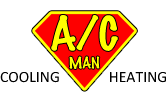A Guide By The #1 AC Repair Company On How Air Conditioners Work In Houston
If you moved recently from a house where you mainly used window-mounted air conditioners, fans, or were considering having a central air unit installed, you might not be that familiar with central air conditioning systems. However, don’t worry. We are here to help you with AC repair Houston services. Air conditioning units work the same way that the refrigerator does, just on a bigger scale. Basically, your air conditioner converts gas quickly into liquid and then back again through using a chemical that transfers heat from in the air from inside of your house to the outside.
Ducts
Basically how it works is that heat is pulled out of a home by split cooling systems with refrigerant that circulates in between the air handler and condenser. Cool air is distributed by the supply ducts from the air handler into the rooms in your house. Warm air is carried back by the return ducts to the air handler so that it can be cooled and filtered through a 16x25x1 furnance Filter or similar. When ducts are sized properly they deliver conditioned air quietly and evenly throughout your home. We offer many services at our ac repair Houston company, especially for residential properties.
Registers
Every room needs to have two grilles at least: one that is connected to a return and the other to a supply duct. Supply registers should ideally be located near or on the ceiling, while return registers should be on or near the floor.
Air Handlers
This type of indoor equipment comes with an expansion valve that transforms refrigeration into a cool liquid that flows throughout the evaporator coils. Air is pushed over the coils by a blower, which heats up the refrigerant into the gas form that is returned to the condenser.
Condensers
A warm gaseous refrigerant is taken from your house, and then the compressor pressurizes it and condenses it back into liquid form as the coils are cooled by a fan.
Indoor Unit
Typically the indoor unit is located in a basement or closet close to where the furnace filter is. The unit is comprised of a coil box containing the evaporator. The evaporator enables the refrigerant – which is a cooling fluid contained inside of the coiled piping and referred to by its brand name sometimes – to absorb heat and evaporate. After the heat has been absorbed from inside of your house, only cool air is left and sent back into your house. Just like water absorbs heat from the stove to evaporate or boil, heat is absorbed by refrigerant from your home. That means that both refrigerant and water turn to vapor from a liquid as heat is absorbed. we offer ac repair Houston services for commercial properties.
Outdoor Unit
Usually, the outdoor unit is located on the side or rear of the house. This is where the heat gets dispersed from inside of your house. It is comprised of a fan, condenser coil, and compressor. The heat that is absorbed from the air in your home gets transferred over to the refrigerant. Next, it gets pumps into the outdoor unit. The heat gets absorbed and the refrigerant moves it over to the outdoor coil, where it passes through the unit’s compressor. The main job of the compressor is to move the refrigerant throughout the air conditioning system. That is important since you can then continue to reuse the refrigerant for cooling your home. This refrigerant gets compressed into a higher pressure and then is moved throughout the condenser or outdoor coil. As the refrigerant is passing through the condenser, ambient air is delivered by a fan across the system’s condenser coil which causes it to cool down. As this process is complete, the heat inside of your home gets dispersed into the air outside of your home. Then the refrigerant gets pumped back inside and the entire process repeats itself.
Were you aware that cooling your home was less about cold air being increase and more about eliminating existing heat? For more related articles check out our ac repair Houston blog or call us for assistance.
